The long winters provide one with plenty of opportunities to observe objects created by various types of ice crystals in the atmosphere. Some close to the ground, others high above. I will cover some of the more common ice halos I have seen and filmed, but if you are interested in more detail on these and the much rarer ones I suggest checking out some of the excellent web sites that cover atmospheric optics.
Fog Bows:
Fog bows are also called white bows, mist bows, or cloud bows and are usually formed when the fog layer is dissipating and the sun is starting to shine through. Rain bow colors and size are affected by the size of the drops in which they form. Rain drops that are 0.1mm or less are almost colorless and are found in fog and clouds, and while fog bows are smaller in diameter than rain bows they tend to be wider. You can also have a lunar fog bow, but they are much rarer. The very small 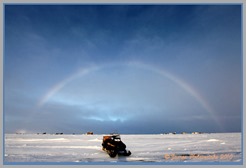 water droplets do not freeze at zero Celsius and so unlike a rainbow, you can have fog bows forming in temperatures below freezing.
water droplets do not freeze at zero Celsius and so unlike a rainbow, you can have fog bows forming in temperatures below freezing.
Photo on the left is a sunlight fog bow in early October arcing over our Homestead.
The second photo on the right shows a lunar fog bow with a hint of aurora borealis in the night sky.
Sun Pillars are created by reflection of sunlight through ice plate crystals as they fall towards the 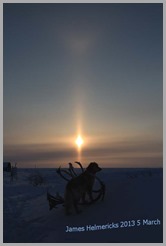 ground with their bases horizontal. This acts like a microscopic mirror reflecting the sun's image up or down depending on which side of the sun the crystals are. Light Pillars are formed from the same ice crystals as those creating a sun pillar, but from an artificial light source on the ground.
ground with their bases horizontal. This acts like a microscopic mirror reflecting the sun's image up or down depending on which side of the sun the crystals are. Light Pillars are formed from the same ice crystals as those creating a sun pillar, but from an artificial light source on the ground.
Both photos show the setting sun with a tall light beam shinning above it. The picture on the right also has a faint tangent arc which is covered in more detail below.
These Two photos show the different colors that develop from an artificial light source.
Atmospheric Halos:
Ice Halos.........ice halos are formed by tiny ice crystals that create rings and different arcs depending on the hexagonal shape of the crystal, which can be narrow columns or thin plates. Both shapes refract and reflect the sun or moon light creating rings and at times various arcs around them.
The most common ice halo is the 22 degree one, but if the cloud cover isn't complete or gets too thick, you may only see part of the halo. If conditions are right for a bright halo it will have a red tinge to the inner part of the circle facing the sun. The halo is caused by refraction of sun or moonlight as it passes through the small hexagonal ice crystals, and will be fainter in the moon light.
This is a photo of a 22 degree lunar halo, also visible is a lower and upper tangent arc.
A 22 degree halo developed as the sun was about to set in the south in early winter.
Some of the rarer arcs seen in conjunction with a halo are tangent arcs, parhelia, parhelic circle, and the circumzenithal arc.
Parhelia.....also called sun dogs are bright patches seen near the edge of a 22 degree halo. They are caused by refraction of hexagonal crystals and can be seen with out a halo or just one bright patch may be visible and is called a parhelion. If the source of light is from the moon they are called parselena or moon dogs.
Parhelic Circle........at times one may see a colorless band parallel to the horizon and level with the sun, this is called the parhelic circle. In rare instances it can form a complete circle opposite to the direction of the sun.
Tangent Arc ... When the sun is low a colored arc can form at the top of the halo, looking like a bird in silhouette, or short spikes. They can also form at the bottom of the halo as the sun increases in elevation, and they are called either a upper or lower tangent arc.
Circumzenithal Arc .. the circumzenithal arc is formed from the same type of crystal as the parhelia, but tend to be brighter with more color than parhelia. In fact they can rival a rainbow for color and brightness, but they differ in that these arcs are on the same side as the sun with the red color closest to the sun with the curve up not down as in a bow.
Setting sun with parhelia/sun dogs on the edge of the 22 degree halo.
This photo shows the white parhelic circle passing through the sun and extending out past the halo. There also weak sun dogs at the edge of the halo.
Here is a good view of a upper tangent arc.
Here we have the bright circumzenithal arc, which is seen above the 22 degree halo and upper tangent if visible.
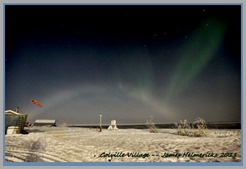
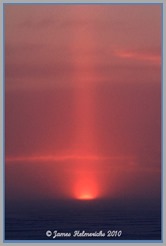
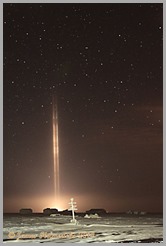

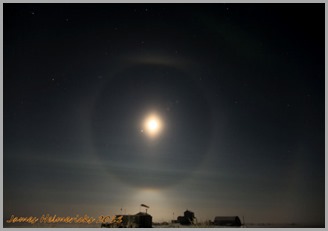
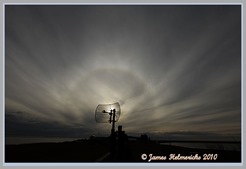
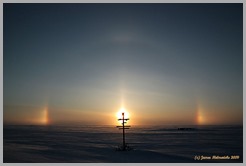
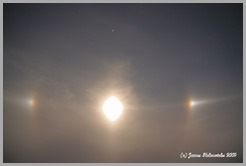
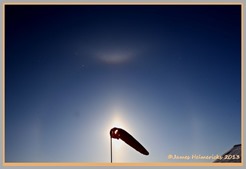
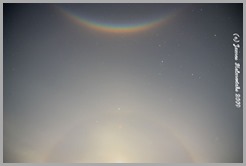
No comments:
Post a Comment